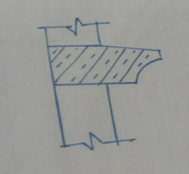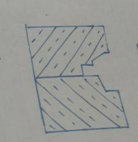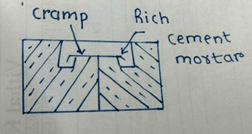This set of Construction and Building Materials Multiple Choice Questions & Answers (MCQs) focuses on “Joints in Stone Masonry”.
1. Identify the type of Joint in stone masonry.

a) Butt joint
b) Rebated joint
c) Tongued joint
d) Saddled joint
View Answer
Explanation: In Butt or square joint, the square surface of one stone is placed again that of another as shown in the given figure above. This is the most common joint and is extensively used for ordinary work.
2. Identify the type of Joint in stone masonry.

a) Table joint
b) Cramped joint
c) Rebated joint
d) Butt joint
View Answer
Explanation: In Rebated joint, the rebates are provided which prevents the movement of stones. The length of rebate depends on the nature of the work. But it should not be less than 70 mm. This joint is used for arch work, copying on gables, etc.
3. Identify the type of Joint in stone masonry.

a) Rusticated joint
b) Table joint
c) Cramped joint
d) Plugged joint
View Answer
Explanation: In Table joint, a joggle is song in the bed of the stone to prevent lateral movement. The depth of projection is about 40 mm and the width of projection is about one third the breath of the stone. This type of joint is used in case of structures such as sea walls.
4. Identify the type of Joint in stone masonry.

a) Saddle joint
b) Table joint
c) Butt joint
d) Rebated joint
View Answer
Explanation: In Saddle or water joint, the stone is rounded off as shown in the given figure. This type of joint is provided to protect the joints of the cornice and such other weathered surfaces. The saddle is generally bevelled backword from the front edge so as to make it inconspicuous.
5. Identify the type of joint in stone masonry.

a) Plugged joint
b) Dowelled joint
c) Rusticated joint
d) Table joint
View Answer
Explanation: Sometimes the margins or edges of stones used for Plinth, Quoin, outer walls of lower storeys, etc., are sunk below the general level. The term rusticated is used to indicate such masonry. There are three forms of rusticated joints – channel joint, Vee joint, Vee and channelled joint.
6. Identify the type of joint in stone masonry.

a) Butt joint
b) Joggle joint
c) Table joint
d) Cramped joint
View Answer
Explanation: In Tongued and grooved joint, a projection is kept on one stone and corresponding sinking is provided in the other side as shown in above figure. This arrangement prevents the sliding of one stone over the other. This joint is also known as a Joggle joint and is rarely used as it involves a great deal of labour and thus becomes expensive.
7. Identify the type of joint in stone masonry.

a) Rusticated joint
b) Dowelled joint
c) Cramped joint
d) Plugged joint
View Answer
Explanation: In Plugged joint, the dovetail shaped mortices are provided in the sides of adjacent stones as shown in the given above figure. When Stone are placed in position, the molten lead is poured in the joints, which, when cooled, connects the stones firmly.
8. Identify the given type of joint in stone masonry.

a) Rusticated joint
b) Cramped joint
c) Plugged joint
d) Butt joint
View Answer
Explanation: In Cramped joint, the cramps are used instead of dowels. The cramps are the pieces of non corrosive metal such as gunmetal, copper, etc. and their ends are turned down to a depth of about 40 mm to 50 mm. The length, width and thickness of the cramps vary from 200 mm to 300 mm, 25 mm to 15 mm and 5 mm to 10 mm respectively.
9. In ________ joint, a hole is cut into each stone and loose dowels l, which are small pieces of hard stone, Slate, gunmetal, brass, bronze or copper, are inserted and secured with the cement.
a) Cramped joint
b) Plugged joint
c) Dowelled joint
d) Table joint
View Answer
Explanation: The Dowelled joint, when adopted for columns, is known as a Bed Plug. The dowels are generally 25 mm thick and 100 mm to 150 mm long. This joint also ensure stability of the stones against the displacement.
10. With the help of __________ arrangement, any water moving on the way that surface is diverted from the joints.
a) Saddle joint
b) Rebated joint
c) Table joint
d) Grooved joint
View Answer
Explanation: In Water joint or Saddle joint, the stone is rounded off. The saddle is generally bevelled back word from the front edge so as to make it inconspicuous. This type of joint is provided to protect the joints of the cornice and such other weathered surfaces.
Sanfoundry Global Education & Learning Series – Construction and Building Materials.
To practice all areas of Construction and Building Materials, here is complete set of 1000+ Multiple Choice Questions and Answers.
If you find a mistake in question / option / answer, kindly take a screenshot and email to [email protected]
- Check Construction and Building Materials Books
- Check Civil Engineering Books
- Practice Civil Engineering MCQs
- Apply for Civil Engineering Internship
